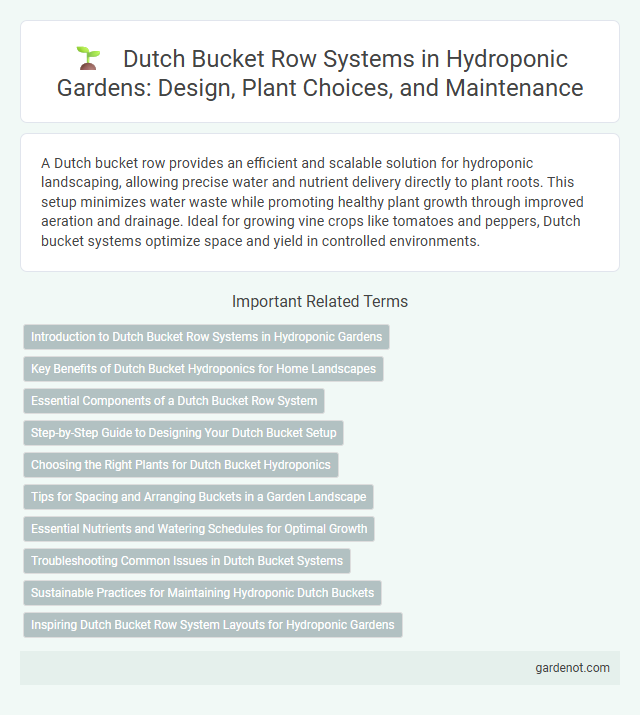A Dutch bucket row provides an efficient and scalable solution for hydroponic landscaping, allowing precise water and nutrient delivery directly to plant roots. This setup minimizes water waste while promoting healthy plant growth through improved aeration and drainage. Ideal for growing vine crops like tomatoes and peppers, Dutch bucket systems optimize space and yield in controlled environments.
Introduction to Dutch Bucket Row Systems in Hydroponic Gardens
Dutch bucket row systems in hydroponic gardens provide an efficient method for growing medium to large crops such as tomatoes, peppers, and cucumbers. These systems use individual buckets filled with inert growing media, connected by a recirculating nutrient film that ensures precise water and nutrient delivery. The modular design supports optimal root aeration and easy maintenance, promoting healthy plant growth and maximizing yield.
Key Benefits of Dutch Bucket Hydroponics for Home Landscapes
Dutch bucket hydroponics offers efficient water and nutrient management, minimizing waste while promoting healthy plant growth in home landscapes. This system supports a wide variety of crops, including tomatoes, cucumbers, and peppers, ensuring diverse and consistent yields. Its modular design enables easy scalability and maintenance, making it ideal for urban gardeners seeking space-efficient solutions.
Essential Components of a Dutch Bucket Row System
A Dutch bucket row system includes key components such as individual buckets filled with inert growing media, a drip irrigation line to deliver nutrient-rich water, and a drainage system that collects runoff for recirculation. Each bucket supports root development and prevents cross-contamination between plants, optimizing water and nutrient efficiency. The frame or support structure maintains bucket alignment and facilitates easy access for maintenance and harvesting.
Step-by-Step Guide to Designing Your Dutch Bucket Setup
Designing a Dutch bucket setup begins with selecting durable buckets, typically 5-gallon containers, arranged in rows for efficient water flow and nutrient delivery. Install a recirculating drip irrigation system with emitters positioned at each bucket to ensure consistent hydration tailored for crops like tomatoes or cucumbers. Incorporate a reliable reservoir and pump system to circulate nutrient-rich water, optimizing oxygenation and minimizing waste for sustainable hydroponic cultivation.
Choosing the Right Plants for Dutch Bucket Hydroponics
Selecting plants with strong root systems like tomatoes, peppers, and cucumbers is essential for Dutch bucket hydroponics due to their nutrient uptake efficiency and space optimization. Crops that require moderate water and nutrient levels, such as eggplants and herbs like basil, thrive well in this system by reducing the risk of waterlogging and disease. Prioritizing plants suited to the bucket's drainage and aeration characteristics enhances growth performance and yield consistency in hydroponic landscapes.
Tips for Spacing and Arranging Buckets in a Garden Landscape
Space Dutch buckets at least 18 to 24 inches apart to ensure adequate airflow and root development, preventing disease and encouraging healthy plant growth. Arrange buckets in straight or slightly staggered rows to maximize sun exposure and simplify irrigation management. Position buckets to allow easy access for maintenance and harvest, enhancing overall garden efficiency and plant care.
Essential Nutrients and Watering Schedules for Optimal Growth
Dutch bucket rows in hydroponic landscapes require precise management of essential nutrients like nitrogen, phosphorus, potassium, calcium, and magnesium to support vigorous plant growth. Maintaining a consistent watering schedule, typically every 30 to 60 minutes during peak daylight hours, ensures optimal nutrient uptake and prevents root dehydration. Monitoring pH levels between 5.5 and 6.5 enhances nutrient availability and maximizes crop yield in this system.
Troubleshooting Common Issues in Dutch Bucket Systems
Clogged drip emitters and uneven water distribution are common issues in Dutch bucket hydroponic systems, often caused by mineral buildup or root intrusion. Regular flushing of irrigation lines and routine inspection of emitter functionality ensure consistent nutrient delivery to plants. Monitoring water pH and electrical conductivity (EC) levels helps maintain optimal growing conditions and prevents nutrient lockout.
Sustainable Practices for Maintaining Hydroponic Dutch Buckets
Sustainable practices for maintaining hydroponic Dutch bucket systems prioritize water recycling and nutrient management to reduce waste and environmental impact. Utilizing organic fertilizers and integrated pest management helps maintain plant health while minimizing chemical usage. Implementing drip irrigation and regular monitoring of pH and EC levels ensures optimal resource efficiency and promotes eco-friendly cultivation.
Inspiring Dutch Bucket Row System Layouts for Hydroponic Gardens
Dutch bucket row systems optimize space and resource efficiency by arranging buckets in linear, modular configurations ideal for hydroponic vegetable and fruit production. Incorporating drip irrigation and recirculating nutrient solutions, these layouts enhance plant health and yield while simplifying maintenance. Popular designs integrate adjustable spacing and vertical supports to maximize light exposure and airflow in commercial and home hydroponic gardens.
Dutch bucket row Infographic

 gardenot.com
gardenot.com